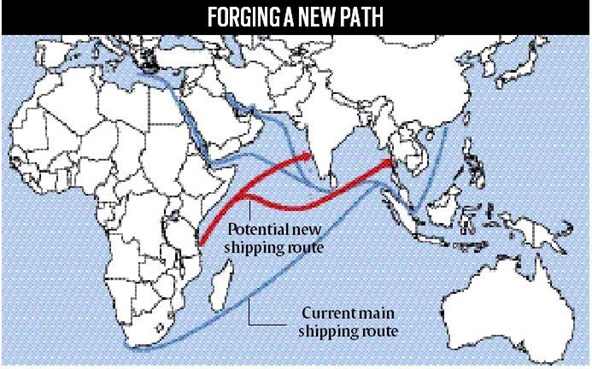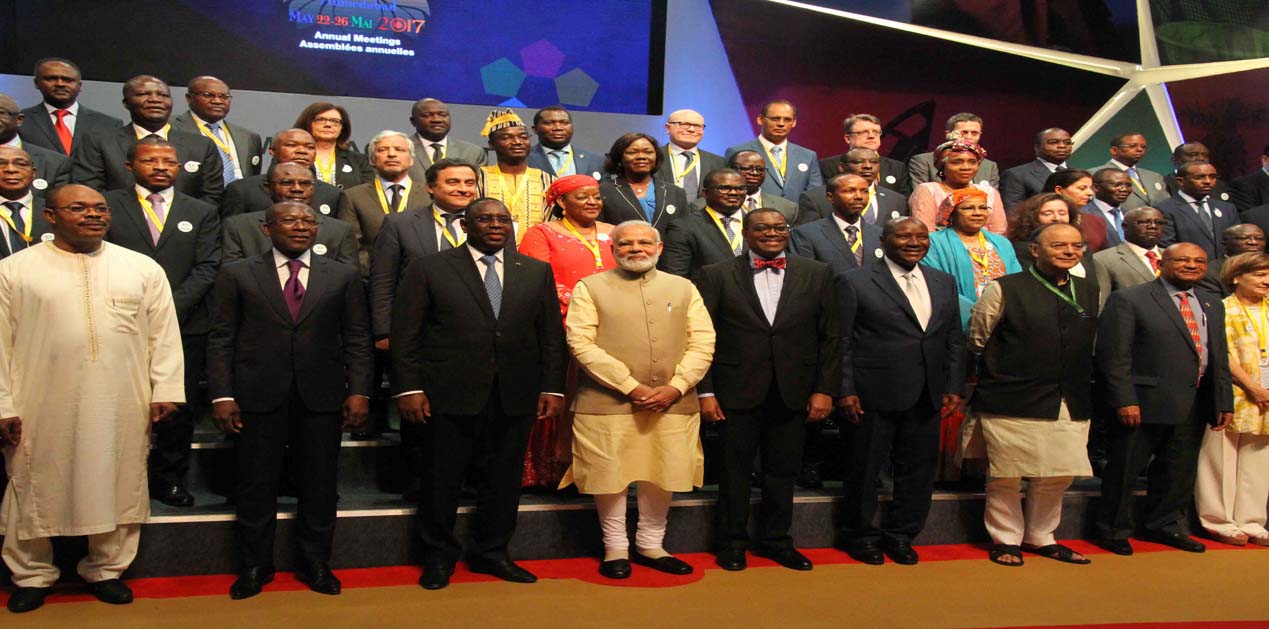AAGC Vision Document - Origin and Institutions behind its Creation?
Asia-Africa Growth Corridor (AAGC) supported by Japan and India was unveiled on 24th May, 2017 during the 52nd Annual Meeting of the African Development Bank (AfDB) held in Gandhinagar, Gujrat. The vision document has been prepared jointly by three agencies, namely: (i) The Research and Information System for Developing Countries (RIS) New Delhi; (ii) The Economic Research Institute for the Association of Southeast Asian Nations and East Asia (ERIA) Jakarta; and, (iii) Institute of Developing Economies Japan External Trade Organisation (IDE-JETRO), Tokya (Pathak Maulik, Live Mint, 2017). Prime Minister Shri Narendra Modi, attended the inaugural of the annual meetings of the AfDB where he pushed for AAGC supported by Japan and India, a pitch coming days after China's ambitious One Belt, One Road (OBOR) initiative taking off. The AAGC is a roadmap of opportunities and aspirations in Asia and Africa, launched with a perceptive that it will give priorities to developmental projects in health and pharmaceuticals, agriculture and agro processing, disaster management and skill enhancement.
The idea of AAGC had initially emerged in the joint declaration issued by the Prime Minister and his Japanese counterpart Shinzo Abe in Novemeber, 2016. During his visit to Japan in 2016, Shri Narendra Modi and Shinzo Abe had laid great emphasis on improving the connectivity between Asia and Africa. Both focused on free and open Indo-Pacific region which plays a vital role in achieving prosperity of the region. Emphasis was also on the importance of India-Japan dialogue to promote cooperation and collaboration in Africa, with the aim to combine the efforts of both the leaders to explore specific joint projects, which covers areas of training and capacity building, health, infrastructure and connectivity. Further, they also expressed their intention to work jointly and cooperatively with the international community to promote the development of industrial corridors and industrial network in Asia and Africa.
Is AAGC a Counter to OBOR?
AAGC is a consultative initiative which is essentially a sea corridor unlike OBOR, which entails development of a land. AAGC is said to link Africa with India and other countries of South-East Asia and Oceania. The initiative is considered to be a “distinct initiative” which would be profitable and bankable, borne out of a consultative process, unlike the 'government - funded model' of the OBOR project. The AAGC is built on the pivot that rather than excessive emphasis on trade and economic relations, the centrality of people in Africa needs to be brought to the fore front.
India denied joining China’s ambitious OBOR project. This venture has similar goals of inter-connectedness but focuses more on Eurasian countries and increased trade cooperation. Now, India has instead divulged its AAGC plan in collaboration with Japan. China is still hoping to get greater market access in Africa through OBOR (Dave Devanshee, pg 1, 2017). However, India has great trade and network experience in Africa, and Japan has very advanced technology. Also, Japan’s ability to deliver quality infrastructure will play a major role in developing this corridor. This combination will give China tough competition for market share. On the other hand, Japan is ready to commit about $200 billion in the proposed growth corridor. An announcement on the same is expected to be made in the month of September this year. Japan has already invested about $32 billion in infrastructure projects in Africa (Pathak Maulik, Live mint pg. 2, 2017).

More information will be reveled about the AAGC during the upcoming visit of Japanese Prime Minister to India in September this year. Prima facie, as per the vision document, the next step is the preparation of a 'vision study' for the project, for which a Research Support Unit will be set up in RIS. The unit will conduct the preparation of AAGC study between 2017-2018. The report will be presented to the Government of India and Japan, and other leaders and policy makers of Asia and Africa in 2018.
The initiative is said to envisage people centric sustainable growth strategy details, which would be evolved through a process of detailed consultation across Asia and Africa. As per the vision document, the four key pillars of AAGC include: (a) Enhancing Capacity and Skills; (b) Quality Infrastructure and Institutional Connectivity; (c) Development and Cooperation projects; and lastly, (d) People-to-people partnership. The vision document lays out many fields of collaboration as well. The digital connectivity will support the growth of innovative technology and services between Asia and Africa. Under this initiative it is noted that there is immense scope for Asia to share its experiences of growth and development with Africa. The AAGC consists of five remarkable focal points: (a) effective mobilisation of financial resources; (b) their alignment with socio-economic development and development strategies of partner countries and regions; (c) application of high-quality standards in terms of compliance with international standards established to mitigate environmental and social impact; (d) provision of quality of infrastructure taking into account aspects of economic efficiency and durability, inclusiveness, safety and disaster-resilience, sustainability as well as convenience and amenities; and (e) contribution to the local society and economy.
The model of AAGC stresses on developing countries by investing in those countries’ priority issues. Such an investment philosophy creates a win-win situation for all: it’s about gaining advantages by aiding other countries. The AAGC will provide a great chance for India to improve its position in the global market. Additionally, as the Chinese economy is facing a slowdown, India will hopefully be on the upswing with the AAGC vision. As of now, all the three regional research agencies are planning continual improvements to improve the AAGC project. Further insight to the plan will be discussed when the Japanese Prime Minister Shinzo Abe visits India this upcoming September. But sooner or later, this plan will surely set into motion a new phase for India of competition within the global economy.
Chinese Presence in the African Continent
The African continent is an extremely lucrative destination for the Chinese government. In 2015, the five of the fastest growing economies in Africa were non-resource rich, with Ethiopia, Cote d’Ivoire and Rwanda leading the pack with GDP growth rates of 10.2 per cent, 8.8 per cent and 7.1 per cent, respectively. Similarly, in 2016, countries like Senegal clocked a growth rate of 7.5 per cent, while Ethiopia (8 per cent), Kenya (6.5 percent) and Tanzania (7 per cent) all recorded impressive growth. The Chinese influence on the African economy can be gauged from the 2017 African Economic Outlook, released at the AfDB summit, which showed that China was still the major consumer of African goods, accounting for 27 per cent of Africa’s total global exports. China is also a leader in Greenfield investment in Africa; in 2015-16, the country invested a whopping USD 38.4 billion (24 per cent of total Greenfield investment). In comparison, India during the same year, invested just USD 2.2 billion (1.3 percent of total Greenfield investments) across 64 Greenfield projects (Nair Avinash, The Indian Express 2017). In the year 2014, Africa accounted for 11 percent of India’s exports and 9 percent of its imports. Since 2010, India’s exports to and imports from Africa increased by 93 percent and 28 percent, respectively. In the meantime, Africa’s share from India’s total exports has increased from 8.1 percent to 10.9 percent. Overtaking the United States of American with 40 billion of US Dollars of imports, India came as third African trade partner, in 2014 just after the European Union and China (https://www.tralac.org/news/article/8371-africa-india-facts-and-figures-2015.html). As per the data available with the government, in 2014-15 Africa’s trade contributed 9.4 percent of India's total trade which is $71.65 billion of $758 billion. Of India's total exports of $310.34 billion, Africa accounted for 10.6 percent or $32.8 billion. While in the country's imports, Africa's contribution was 8.7 percent which is $38.8 billion of $447.96 billion (Pandathil & Kishore, First Post 2017). In the year 2015, China which is Africa's largest trading partner, recorded total trade in Africa worth approximately $179bn, while Japanese trade with the continent stood at $24bn (Al Jazeera, 2016).Thus, we see that compared to India and China the Japanese investments at present are minuscule.
Japan and India’s Contribution to the AAGC
The AAGC is an attempt to create a “free and open Indo-Pacific region” by rediscovering ancient sea-routes and creating new sea corridors that will link the African continent with India and countries in South Asia and South-East Asia. The project stakeholders hope the sea corridors will be ‘low-cost’ and have ‘less carbon footprint’ when compared to a land corridor. For instance, under the AAGC, there is a plan to connect ports in Jamnagar (Gujarat) with Djibouti in the Gulf of Eden. Similarly, ports of Mombasa (Kenya) and Zanzibar (Tanzania) will be connected to ports near Madurai (Tamil Nadu) and Kolkata will be linked to Sittwe port (Myanmar).
Apart from developing sea corridors, the AAGC also proposes to build robust institutional, industrial and transport infrastructure in growth poles among countries in Asia and Africa. The idea is to enable economies in Asia and Africa to further integrate and collectively emerge as a globally competitive economic bloc. Japan’s contribution to the project will be its state-of-the-art technology and ability to build quality infrastructure, while India will bring in its expertise of working in Africa. The private sector of both countries are expected to play a big role by coming together to form joint-ventures and consortiums; to take up infrastructure, power or agribusiness projects in Africa. Apart from India and Japan, South Africa, Mozambique, Indonesia, Singapore, and Australia sent representatives for the consultation process. Quizzed about China, Anita Prakash, Director General of ERIA, said her organisation represented the ASEAN region and six other countries including China. Moreover, she added, ERIA also has Chinese scholars working for it on this project (Nair Avinash, The Indian Express 2017).
Response of African Nations to the AAGC Vision Document.
The African Development Bank has welcomed the AAGC vision document. Trade corridors have always existed between Africa and Asia, thus, AAGC becomes more important because infrastructure is costly and there is a need to have infrastructure everywhere. There have to be particular zones where infrastructure has to be build. The AfDB President Akinwumi Adesina in the annual meeting at Gandhinagar also showed his interest and mentioned that they are already working on growth corridors within the African continent.
Few of the officials have stated that more studies will be undertaken to list the current demands and challenges of economic, socio-cultural and political partnership pertaining to AAGC. This will bring out the existing challenges and barriers to this project. It will also spell out the cooperation aspects of sustainable growth and development exchange of best practices. Based on all these aspects, future AAGC studies will make recommendations to the governments of India and Japan and to governments in Africa, South Asia, Southeast Asia, East Asia and Oceania on the way forward for deepening this partnership (Nair Avinash, The Indian Express 2017). Further details of how to proceed on building the AAGC corridor will be presented either when Prime Minister Narendra Modi meets his Japanese counterpart Shinzo Abe on the sidelines of the G20 meet at Hamburg (Germany) in July or when India hosts the Japanese Prime Minister in September.
Conclusion
At the India-Africa Forum Summit 2015, Prime Minister Shri Modi announced a $10 billion line of credit that marked a new approach towards the engagement with African countries. This not only helped finance the projects in African countries but also contributed to capacity-building and education. India is the fifth-biggest investor in Africa, with investments over the past 20 years amounting to $54 billion, by extension, creating millions of jobs for African citizens. Prime Minister Shri Modi while inaugurating the AfDB annual meeting also mentioned that India is working with the United States and Japan to support development in Africa. He vigorously emphasised that his government has made Africa a top priority for foreign and economic policy. Thus, with the AAGC Vision Study, a broad roadmap would be laid for development of the project, bringing in the geographical simulation model (GSM) for economic gains for Africa through its integration with India, South Asia, Southeast Asia, East Asia and Oceania.
It would be prudent to note that the Indo-Japanese fulcrum for the development of both Africa and the South Asian region will bring the two continents closer to each other. It would be but natural for the intelligensia to look at AACG as an Indo-Japanese counter-pivot to the OBOR, however, it would do injustice to the underlying ideal of a comprehensive and holistic socio-economic development for all involved which forms the crux of the AAGC.
Endnotes
Al Jazeera, 2016, http://www.aljazeera.com/news/2016/08/japan-pledges-invest-30bn-africa-160827175912890.html
"Asia-Africa growth corridor launched". The Times of India. TNN. 25 May 2017.
Chaudhury Dipnoan (26 May 2017). "India, Japan come up with AAGC to counter China's OBOR". The Economic Times. Retrieved 31.05.2017.
Dave Devanshee, ‘The Growth Corridor: India’s future with Asia and Africa’. The Indian Economist, 29th May 2017.
Nair Avinash, ‘To counter OBOR, India and Japan propose Asia-Africa sea corridor’, The Indian Express, May 31, 2017
Pathak Maulik, ‘India-Japan partnership to play key role in Asia-Africa corridor’, Live mint 25th May 2017.
Vora Rutam,"Asia-Africa Growth Corridor: Vision document focusses on inclusivity". Business Line, May 24, 2017.
http://www.ptinews.com/news/8728761_Modi-bats-for-Asia-Africa-growth-corridor.html
http://www.livemint.com/Politics/gfSbaVJjfHuoUKPTMxrU8L/IndiaJapan-partnership-to-play-key-role-in-AsiaAfrica-corr.html
http://www.financialexpress.com/economy/vision-document-for-asia-africa-growth-corridor-unveiled/684319/
https://www.tralac.org/news/article/8371-africa-india-facts-and-figures-2015.html
Pandathil Rajesh and Kishor Kadam. 2017, “Nigeria is India's top African partner: India-Africa Trade explained in 5 graphics” First Post, 2017.
Image Source: http://www.gujaratglobal.com










Post new comment